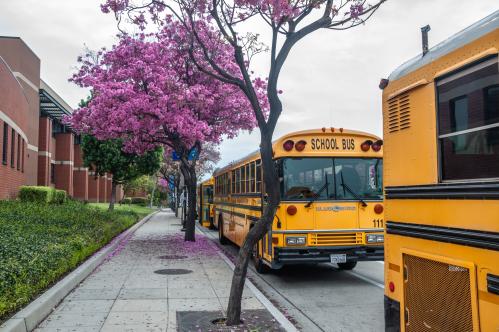This post is part of the “Community Schools Leader Insights” series with perspectives from leaders who have guided the evolution of community schools through innovative approaches across a wide range of geographies.
Chicago Public Schools (CPS) are home to more than 322,000 students who attend 635 schools. In its nearly 200-year-long history, Chicago’s schools have faced segregation, fiscal crises, and calls for “real equity.” In order to make strides in supporting student success, CPS has invested in the community schools strategy to connect the dots among community partnerships, strong school leadership, and academic achievement. Community schools aim to transform schools and accelerate student success based on the unique priorities and strengths of local communities. As community school strategies have grown in Chicago, independent evaluations have shown improvements in school-day attendance, academic achievement outcomes such as GPA and NWEA scores, school-related behaviors, and outcomes related to school climate.
Chicago’s community schools have evolved over the past two decades, with both successes and lessons learned.
Chicago’s landscape of community schools has evolved multiple times since 1998, when 50 schools adopted the strategy through a braiding of resources, investment in relationships, and shared visions. Insights from leaders reveal how these community schools evolve, survive, and thrive as implementation unfolds and as funding shifts.
By 2001, CPS deepened their commitment to the strategy by increasing the number of community schools to 150 within three years. In the subsequent decade, Chicago had expanded to 205 community schools before school closings and funding shifts resulted in a decrease to 117 schools.
Due to a variety of increases in funding streams ranging from the local Sustainable Community Schools (SCS) Initiative, federal Full-Service Community Schools grant program (FSCS), and yearly federal 21st Century Community Learning Centers Grants, the total number of community schools are increasing again. This major increase in federal funding for community schools has led to a resurgence occurring not just in Chicago, but nationally.
Community partners are key to continuity through school closings and funding shifts.
Community schools in Chicago have been bolstered through a number of processes and inputs, including partnerships with institutions of higher education, such as the University of Chicago’s Consortium on School Reform and its School of Social Work, which no longer exists, but developed an explicit certification and learning process for community school coordinator and resource manager positions. Community-based organizations in Chicago, in partnership with the Coalition for Community Schools and the now defunct Public Education Fund, also co-developed a foundational set of pillars that contributed to national strategy.
Additionally, the SCS Initiative, included in the Chicago Teachers Union contract of 2016, was a critical input that emerged from the hunger strike to reopen Walter H. Dyett High School, the last open-enrollment high school in the Bronzeville neighborhood. Some of the original local community-based organizations who were involved are still working with community schools in the city today, such as Brighton Park Neighborhood Council, Enlace, Youth Guidance, and Blocks Together.
Strong school leadership leads to a shared vision that drives strategy-based implementation and academic outcomes forward.
One of the most important ways a school leader can move toward implementation is by establishing a shared vision for school success. Autumn Berg, manager for the Community Schools Initiative in CPS, emphasized the importance of a comprehensive community school strategy that makes shared leadership, whole-child teaching, and learning central, reimagines how school buildings are being used, and includes communities to inform student learning and connectedness. For Berg, strong school leadership means engaging with parents and students, community members and organizations, local businesses, and educators when making decisions and creating strategies.
“When a principal really foundationally understands a community school strategy and trusts partners, students, and families in supporting that overall strategy, that’s how a community school works,” said Berg. This approach smooths the way for integrating services from community partners into the school, sets a tone for interaction with families, and creates trust in the school community, as described in a 2022 report.
The range of strategies in Chicago most often includes a warm and welcoming environment, increasing student connection to school, improving academic or socio-emotional learning, increasing family engagement, and developing connection to the community. The more time spent in implementation, the greater the focus on whole-child supports on top of a foundation of skill building and a welcoming environment for students.
One school leader was quoted as saying, “We talk about [our shared vision] on a regular basis. It’s posted around the school. It is a living, breathing document. We revamped our vision this year as a school. We got all stakeholders involved in that process.”
Neil Naftzger is a principal researcher working on community school, afterschool, and youth development initiatives at American Institutes for Research (AIR). Naftzger has been tracking the progress of Chicago’s community schools with AIR for more than a decade. He’s found that while seeing results of a shared vision can take time, the youth development and school-related outcomes are well worth investing in the visioning and implementation processes.
Evaluations of Community Schools Initiative programming in Chicago over 11 years have consistently shown positive effects on attendance and disciplinary incidents, as well as increases in annual GPA (0.12 to 0.26 grade points higher), MAP Reading (0.11 standard deviations), and MAP Mathematics (0.20 standard deviations) among some cohorts of schools. Note that these analyses were completed using one of two quasi-experimental designs: (1) a comparative interrupted time series with matched comparison schools in the district or (2) a comparison of students attending CSI-funded programming relative to students from the same schools or other district schools not attending programming. While these designs help control for some sources of selection bias that could impact results, all important sources of selection bias cannot be controlled through these methods. Significant effects associated with CSI implementation were generally positive, although some infrequent, significant negative effects were also found.
Out-of-school learning time and school climate are important for academic success.
Out-of-school learning time with extended day programming focused on academics has also been core to Chicago’s community schools strategy. A study by AIR found that participation in Community Schools Initiative programming for 120 hours or more across the two school years “was found to have a positive impact on both annual GPA and NWEA scores in reading and mathematics.” Positive effects associated with enrollment in SCS school were related to school-day attendance-related outcomes, including high school students who were chronically absent 14 to 15 percent less often and had fewer numbers of suspension days.
There is also a relationship between improvement in school climate and culture measured by Chicago’s 5Essentials survey and the quality of experiences youth were having in afterschool programming. Schools where youth reported more positive experiences related to interest and engagement in afterschool programs demonstrated more improvement on school-related climate and culture. These include scores in peer support for academic work, student-teacher trust, academic engagement, emotional health, knowledge of human and social resources in the community, rigorous study habits, and psychological sense of school membership.
Naftzger has noticed that when students gain familiarity with new topics in out-of-school programs, they can develop new interests and passions in areas like STEM. He said, “High-quality afterschool programs create opportunities for youth to stretch, try something new, and work hard to get better at something that matters to them. These opportunities also lead to students gaining a sense of accomplishment and agency, which are critical factors in their academic success.”
Measuring success starts with agency, belonging, and well-being of students.
As schools move toward more consistent impact on academic outcomes, early indicators of the success of a community school may be present in school climate, culture, attendance, and relationships. Given that community schools are grounded in relationship-driven strategy, Naftzger recommends looking at interactions and relationships first: “Implementation takes time. It’s important not to instantaneously believe you will shift test scores in one to two year’s time in a way that will be detectable. It’s important to invest in the early processes that are part of community schools strategies.”
Chicago community school leaders practice this approach grounded in relationships and support for youth in developing a greater psychological sense of connection to school, a sense of place, belonging, and emotional health—toward long-term academic and school success.
The Brookings Institution is committed to quality, independence, and impact.
We are supported by a diverse array of funders. In line with our values and policies, each Brookings publication represents the sole views of its author(s).






Commentary
Chicago community schools show how long-term investments can yield lasting results
December 20, 2022